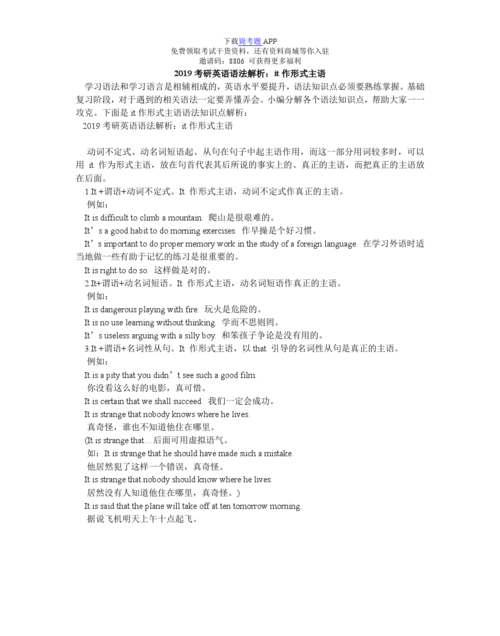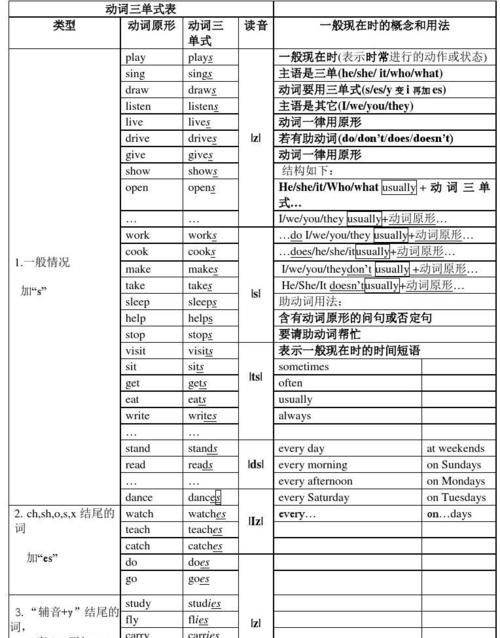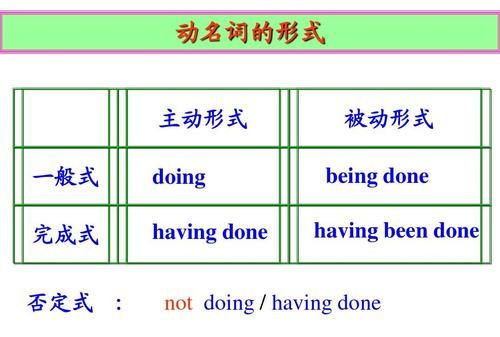本文目录
怎样构成合同诈骗
一般来说 verb+ing就是动名词
例如
smoke吸烟
would you mind my smoking here?其中的smoking就是动词+ing做my的名词
------------------
动名词具有名词的性质,因此在句中可以作主语、表语、宾语、定语等。
作主语
Reading is an art. 读书是一种艺术。
Climbing mountains is really fun. 爬山真是有趣。
Working in these conditions is not a pleasure but a suffer. 在这种工作条件下工作不是一件愉快的事而是一件痛苦的事。
动名词作主语,在动词的基础上加Ing,使该动词或动词短语,有名词的各种特征,可作名词灵活使用。如:
It is no use/no good crying over spilt milk. 覆水难收
It is a waste of time persuading such a person to join us. 劝说这样的人加入真是浪费时间。
It was hard getting on the crowded street car. 上这种拥挤的车真难。
It is fun playing with children. 和孩子们一起玩真好。
There is no joking about such matters. 对这种事情不是开玩笑。
动名词作主语的几种类型
动名词可以在句子中充当名词所能充当的多种句子成分。在这里仅就动名词在句子中作主语的情况进行讨论。
动名词作主语有如下几种常见情况:
1. 直接位于句首做主语。例如:
Swimming is a good sport in summer.
2. 用 it 作形式主语,把动名词(真实主语)置于句尾作后置主语。
动名词做主语时,不太常用 it 作先行主语,多见于某些形容词及名词之后。例如:
It is no use telling him not to worry.
常见的能用于这种结构的形容词还有:better,wonderful,enjoyable,interesting,foolish,difficult,useless,senseless,worthwhile,等。
注意:important,essential,necessary 等形容词不能用于上述结构。
3. 用于“There be”结构中。例如:
There is no saying when he'll come.很难说他何时回来。
4. 用于布告形式的省略结构中。例如:
No smoking ( =No smoking is allowed (here) ). (禁止吸烟)
No parking. (禁止停车)
5. 动名词的复合结构作主语
当动名词有自己的逻辑主语时,常可以在前面加上一个名词或代词的所有格,构成动名词的复合结构(——这时,名词或代词的所有格做动名词的逻辑主语)。动名词的复合结构也可以在句中作主语。例如:
Their coming to help was a great encouragement to us.
6.例词
shopping fishing cycling这些都是很常见的动名词
二、动名词作主语与动词不定式作主语的比较
动词不定式和动名词都可以用作主语。在意义上相近。但动名词多用来表示泛指或抽象动作,不定式多用来表示特指或具体动作。比较:
Smoking is not good for health.
It is not good for you to smoke so much.
注意:
1)在口语中,用动名词作主语位于句首的较不定式多见。
2)在“It is no use...”,“It is no good...”,“It is fun...”,“It is a waste of time...”等句型中,通常用动名词作真实主语:
It is no use/good/a waste of time talking about that.
*It is no use/good/a waste of time to talk about that.
3)在疑问句中,通常用动名词的复合结构,而不用不定式的复合结构作主语:
Does your saying that mean anything to him?
*Does for you to say that mean anything to him?
4)在“There be”句型中,只能用动名词,而不能用不定式作主语:
There is no telling what will happen.
It is impossible to tell what will happen.
5)当句子中的主语和表语都是非限定动词时,要遵循前后一致的原则,主语和表语在形式上要求统一:
Seeing is believing.
*To see is to believe.
作宾语
(1)作动词的宾语
某些动词后出现非限定性动词时只能用动名词作宾语,不能用不定式。常见的此类动词有:admit,appreciate,excuse,stand,advise, allow, permit, avoid, consider, enjoy, finish, give up, cannot help, imagine, include, keep,understand, keep on, mind, report,risk,miss, put off, delay, practise, resist, suggest, depend on, think about, set about, succeed in, worry about, burst out, insist on, can't help, feel like,be used to, get used to, devote…to…, look forward to, pay attention to, get down to,escape 等。如:
They went on walking and never stopped talking.
他们继续走,说个不停。
I found it pleasant walking along the seashore.
在海滩上走真是乐事。
Mark often attempts to escape being fined whenever he breaks traffic regulations.
每当马克违反交通规则时,他常常企图逃避罚款的处分。
(2)作介词的宾语
We are thinking of making a new plan for the next term. 我们正考虑为下学期制定新的计划。
Shall we have a rest or get down to doing our work? 我们休息呢还是开始干活?
(3)作形容词的宾语
The music is well worth listening to more than once. 这种曲子很值得多听几遍。
We are busy preparing for the coming sports meet. 我们正为马上到来的运动会忙着做准备。
作表语
动名词作表语时句子主语常是表示无生命的事物的名词或what引导的名词性从句。表语动名词与主语通常是对等的关系,表示主语的内容,主语、表语可互换位置。
Your task is cleaning the windows. 你的任务就是擦窗户。(Cleaning the windows is your task.)
What I hate most is being laughed at. 我最痛恨的就是被别人嘲笑。 (Being laughed at is what I hate most.)
作定语
动名词作定语往往表示被修饰词的某种用途。如:
a walking stick =a stick for walking=a stick which is used for walking
a washing machine=a machine for washing=a machine which is used for washing
a reading room=a room for reading=a room which is used for reading
a measuring tape=a tape for measuring=a tape which is used for measuring
sleeping pills=pills for sleeping=pills which is used for sleeping
编辑本段
结构和形式
动名词的否定结构
动名词的否定结构由not 动名词组成。如:
Trying without success is better than not trying at all.
实验没有成功也比不实验好。
He hated himself for not having work hard.
他悔恨自己没有用功。
I’m sorry for not having telephoned you before.
很抱歉,没有早给你打电话。
He felt sorry for not having done the work well.
他为没有把工作做好感到难过。
I fancy it has done you a lot of good not going.
我看不去对你倒好了。(not going 是动名词一般式的否定形式)
There is no denying the fact that he si diligent. (no denying 也是动名词一般式的否定)
动名词复合结构
通常情况下,动名词的逻辑主语为谓语动词的主语。如果动名词动作的发出者不失谓语动的主语时,则需要有自己的逻辑主语物主代词或名词所有格加动名词就构成了动名词的复合结构,这种结构在句中可以作主语,宾语等。
(1)逻辑主语是有生命的名词作主语时,必须用名词或代词所有格,作宾语时(尤其在口语中),也可用名词普通个或人称代词宾格。如:
Do you think my going there will be of any help?
你看我去会有什么帮助吗?(宾语)
The student’s knowing English well helps him in learning French.
这位学生通晓英语对他学法语很有帮助。(主语)
Do you mind my(me) smoking ?
你介意我抽烟吗?(宾语)
They insist on Mary’s (Mary) going with them there.
他们坚持要玛丽跟他们一起去那儿。(介词宾语)
(2)逻辑主语是无生命名词是,通常只用名词普通格。如:
Do you hear the rain pattering on the roof?
你听见雨点打在屋顶上了吗?
Is there any hope of our team winning the match ?
我们对赢得比赛有希望吗?
(3) 逻辑主语是指示代词或不定代词this that , somebody , someone , nobody, none, anybody, anyone 时,只用普通格。如:
She was woken up by somebody shouting outside.
她被外面喊叫的人吵醒了。
形式(一般式,完成式和被动式)
(1) 动名词的一般式所表示的动作与谓语动词所表示的动作同时发生,或在谓语动词表示的动作之后。如:
We are very interested in collecting stamps.
我们对集邮很感兴趣。
His coming will be of great help to us .
他来对我们大有帮助。
但是有些明确表示时间的动词和介词 after, on,upon, 或for之后,常用一般式代替完成式,表示动作发生在谓语动作之前。如:
I shall never forget seeing the Great Wall for the first time.
我永远不会忘记第一次看到长城的情景。
On hearing that bad news , the mother couldn’t help crying.
一听到这个糟糕的消息,母亲就禁不住哭了起来。
Excuse me for coming late.
我来晚了,请原谅。
Thank you for giving us so much help.
谢谢你给了我们这么多帮助。
(2) 动名词的完成式所表示的动作或状态在谓语动词之前完成或结束。
He regrets not having taken part in the work.
他后悔没有参加这项工作。
We were praised for having finished the work ahead of time.
我们因提前完成了这项工作而受到了表扬。
(3)动名词的被动式:当动名词的逻辑主语是行为承受者时,用被动语态。如:
I like being given harder work.
我喜欢接受难点的工作。
She is proud of being admitted into the university.
她为被大学录取而感到自豪。
The meeting was put off without his having been consulted.
会议延期并未和他商量。
He doesn’t mind having been criticized.
他不介意过去受到的批评。
编辑本段
动名词的逻辑主语
带有逻辑主语的动名词称为动名词的复合结构。当动名词的逻辑主语与句子的主语不一致时,要在动名词之前加上物主代词或名词所有格,这便构成了动名词的复合结构。其中物主代词(名词所有格)是逻辑上的主语,动名词是逻辑上的谓语。动名词复合结构在句中可作主语、宾语、表语等,分别相当于一个主语从句、宾语从句、表语从句。如:
Her coming to help encouraged all of us. 他来帮忙鼓舞了我们所有人。 (=That she came to help encouraged all of us.)
Jane’s being careless caused so much trouble. 简的粗心惹来了不少麻烦。 (=That Jane was careless caused so much trouble.)
What’s troubling them is their not having enough food. 烦扰他们的是食物不足。 (=What’s troubling them is that they have not enough food.)
在口语中,如果动名词复合结构作宾语,其中的物主代词常用人称代词宾格,名词所有格常用名词普通格来代替,但在句首作主语时不能这样来代替。如:
Would you mind my/me using your computer? 用下你的电脑介意吗?
The father insisted on his son’s/his son going to college. 爸爸坚决要求儿子上大学。
Mary’s (不可用Mary) being ill made her mother upset. 玛丽病了,使她妈妈很着急。
His (不可用Him)smoking made his family angry. 他抽烟使他一家人非常生气。
在下列情况下动名词的逻辑主语必须用名词的普通格或人称代词宾语:
a.无命名词
The baby was made awake by the door suddenly shutting. 这个婴儿被猛烈的关门声吵醒。
b. 有生命名词但表示泛指意义
Have you ever heard of women practising boxing? 你听说过妇女练拳击吗?
c. 两个以上的有生命名词并列
Do you remember your parents and me telling about this? 你记得你父母和我都告诉过你这事吗?
编辑本段
动名词的时态和语态
动名词的时态和语态如下:
时态
主动语态
被动语态
一般式
writing
being written
完成式
having written
having been written
其否定形式是在doing前加上not
1、动名词一般式表示的动作通常是一般性动作,即不是明确地发生在过去、现在或将来的动作,或是与谓语动词所表示的动作同时发生的动作。如:
I hate talking with such people. 我讨厌与这样的人说话。
Being careless is not a good habit. 粗心不是一个好习惯。
2、动名词的完成式表示的动作发生在谓语动词动作之前。如:
I don’t remember having met him before. 我记不得以前见过他。
Thank you for having taking so much trouble to help. 谢谢你费力帮忙。
3、动名词的逻辑主语同时也是动名词动作的承受者,动名词用被动语态。
(1)它的一般式表示的动作与谓语动词动作同时发生,或在其前发生。如:
I don’t like being laughed at in public. 在公共场合下,我不喜欢被别人嘲笑。
(2)它的完成式表示的动作发生在谓语动词之前。如:
I am very pleased at your having been honoured with a medal. 我很高兴你能获得这样的奖牌。
(3)在某些动词,我们常用动名词的一般式表示完成式,尽管动作发生在谓语动词动作之前,这似乎是一种强大的习惯。如:
Excuse me for being late. 我来晚了请你原谅。
I don’t remember ever meeting somewhere. 我记不得原来在什么地方见过。
Thank you for giving us so much help. 谢谢给我们这么大的帮助。
(4)在多数情况下都避免使用动名词被动语态完成式,而用一般式代替,以免句子显得累赘,尤其是在口语中。如:
I forget once being taken (having been taken ) to the city zoo. 我曾被带到过这个动物园,可我忘了。
(5)动名词被动语态一般式与现在分词被动语态一般式同形,但无进行意义,being不可省略。如:
She is afraid of being taken to the public. 她怕被领到大众面前。
编辑本段
常见题型
1) 动名词做主语时,谓语动词为单数
2) 在动名词和不定式中,作为介词的宾语是动名词
3) 动名词的否定直接在其前加否定词,通过代词的宾格或所有格形式给出逻辑主语
例:
I would appreciate_______ back this afternoon.
A.you to call B.you call C.you calling D.you’re calling(Key:C;换成your calling也对)
4) 有些词后只能接动名词
acknowledge;admit; advise;advocate;allow;appreciate; avoid; celebrate; consider; contemplate; defer; delay; deny; detest; discontinue; dislike; dispute; enjoy; it entails; escape; excuse; explain; fancy; feel like; finish; forgive; can’t help; hinder; imagine; it involves; keep; it means; mention; mind; miss; it necessitates; pardon; postpone; practice; prevent; recall; report; resent; resist; risk; suggest; understand...
5) 另外还有一些接-ing形式的常用说法
it’s no good; it’s no/little/hardly any/ use; it’s not/hardly/scarcely use; it’s worthwhile; spend money/time; there’s no; there’s no point in; there’s nothing worse than; what’s the use/point...
6) 有些词后面加不定式和动名词均可
remember, forget, try, stop, go on, continue,stop,regret,cease, mean后面均可用不定式和-ing形式,但意义截然不容。
例:
remember to do/doing:
①I remembered to post the letters.(指未来/过去未来将要做的动作)
②I remembered posting/having posted the letters.(我记得做过这个动作)
forget与remember的用法类似。
regret的用法:
①I regret to inform you that…(我很遗憾地通知你……)
②I regretted having left the firm after twenty years.(为了“二十年前的离开”而遗憾。)
try to(努力)与try +–ing(试验):
①You really must try to overcome your shyness.
②Try practicing five hours a day.
编辑本段
动名词与现在分词的同与不同
动名词它在形式上与现在分词相同,都是在动词原形的词末加-ing。在现代语法中,这两种形式同视为"-ing形式"。 这两种形式的另一个相同之处是:它们都是由动词变化而成的,它们都保留了动词的某些特征,它们都能带自己的宾语、状语,而构成动名词短语或是现在分词短语去担当句子成分。例如:
Speaking in the public , he will surely be very cheerful .
(现在分词短语,作状语)他在公众场所讲话时总是兴高采烈的。
She hates speaking in the public.
(动名词短语,作宾语)她不喜欢在公众场所讲话。
区别:
1?动名词和现在分词都可以用于系动词之后作表语,区别方法是:
①作表语的动名词与主语指的是同一件事,此时系动词相当于“是”,通常把主语和表语的位置互换,语法和意思不变,例如:
My hobby is swimming.可改为Swimming is my hobby.(可将原句中的主语与表语位置互换)
②现在分词作表语主要用以说明主语的性质,不能与主语互换位置,例如:
The story is interesting .不可改为:Interesting is the story.
2?动名词和现在分词都可以用作定语来修饰名词,两者的区别在于:
动名词修饰名词时主要表示该名词的用途,而现在分词修饰名词时性质?状态或动作等?试比较:
①a swimming boy和a swimming suit
前者的意思是“一个正在游泳的男孩”,即a boy who is swimming ,现在分词swimming 表示被修饰名词boy的动作;而后者的意思是“游泳衣”,即a suit for swimming , 动名词swimming表示suit 的用途。
②a sleeping child 和 a sleeping car
前者的意思是“一个正在睡觉的孩子”,即a child who is sleeping ,现在分词sleeping 表示被修饰名词 child 正处于的状态;而后者的意思是“卧车(被用来睡觉的车厢)”,即 a car which is used for sleeping ,动名词 sleeping 表示car 的用途。

初中英语动名词的用法
初中英语动名词的语法
第五节 动名词

1.动名词的形式:
动名词是由动词原形+ing构成(如writing),有完成时态和被动语态(如having written,being written)。
2.动名词的用法
动名词通常在句中作主语和宾语。
1)动名词作主语
Going to the college is the little boy's dream.
Keeping studying hard will make you pass the exam.
2)动名词作宾语
有些动词后面只能带动名词作宾语,不能带不定式作宾语。此类动词常见的有:admit,acknowledge,anticipate,appreciate,avoid,consider,contemplate,defer,delay,deny,detest,dislike,ensure,enjoy,escape,excuse,evade,facilitate,fancy,favour,finish,forbid,imagine,include,keep,mind, miss,postpone,practise,resent,resist,risk,suggest,quit,worth等。例如:
1.John was considering buying a new car.
2.I hope you didn’t contemplate coming with us on this trip.
3.The witness denied having seen the accused man.
4.I would appreciate your keeping it a secret.
3)某些短语后面只能接动名词,不能接不定式。
此类短语常见的有:be (get) used to, be accustomed to, be dedicated to, be devoted to,be busy,be committed to,be suject to,cannot help, cannot resist,cannot stand,confess to,feel like,give up,have trouble(in), have difficulty(in),have a good/hard time(in),have fun(in),have an objection to,it is no good/use,keep on,insist on,look forward to,object to,pay attention to,put off,resort to,succeed in等。例如:
1.I cannot stand getting up early in the morning.
2.I have no difficulty (in) reaching the top of the mountain.
3.There is no use staying on.
4.I cannot resist (his) bargaining.
5.Although punctual himself,the professor was quite used to students’being late for his lecture.
4)动词或短语后面也可以接动名词的被动形式 。用主动形式还是被动形式,要根据句子的意思而定。例如:
a.Carlos just missed being caught.
b.That person wore dark glasses to avoid being recognized.
c.I object to being treated like a child.
3.另一类动词后面可以带动名词做宾语,也可以带不定式作宾语 。这类动词又可以分为两种:
1)带动名词作宾语与带不定式作宾语而意义无多大区别的动词
a) 在begin,cannot bear,cease,continue,dread,like,love,neglect,omit,prefer,propose等动词之后,如表一般的行为,用动名词作宾语为多;如表示特定的或具体的动作,则用不定式结构作宾语为多。例如:
1.I don’t like swimming.
2.I don’t like to swim this afternoon.
3.John prefers doing it his way.
4.John prefers to go outing tomorrow.
b) 在begin, start等动词之后,如表示有意的动作,用动名词结构为多;如表示无意的动作,用不定式结构为多。例如:
1.After some hesitation,he began speaking out his own opinion.
2.It has already begun to rain.
c) 在attempt,intend,plan等动词之后,用不定式结构与用动名词结构意义相同,但以用不定式较为常见。例如:
1.He intended to buy a new car.
2.He intended travelling abroad next summer.
d) 在encourage,permit,allow,recommend,advise,authorise等动词之后,一般用动名词作宾语,或者用不定式作宾语补足语。即:
encourage/permit/allow/recommend/advise/authorise+doing,或encourage/permit/allow/recommend/advise/authorise+somebody+to do。例如:
1.He advised going out for a walk.
2.He advised us to go out for a walk.
e) 在agree,decide等动词之后,可以直接跟不定式结构,但如果跟动名词,则动词后必须加适当的介词。例如:
1.He agreed to do me a favor.= He agreed on doing me a favor.
2.In the end the manager decided to double the advertising budget.=
3.In the end the manager decided on doubling the advertising budget.
f) 在need,want,require, deserve等动词之后,可以用动名词的主动形式表示被动意义,这相当于用不定式的被动形式。例如:
1.The house needs repairing. = The house needs to be repaired.
2.The disabled deserve respecting. = The disabled deserve to be respected. 2)带动名词作宾语与带不定式作宾语而意义不同的动词 a) 动词remember,forget后可以跟不定式或动名词,但意义有明显区别:跟动名词,其动作发生在“记得”或“忘记”的动作之前;跟不定式,其动作发生在“记得”或“忘记”的动作之后。试比较:
1.I remember posting this letter.我记得这封信已经寄出了。
2.I remember to post this letter in the afternoon. 我记得下午要将这封信寄走。
b) 动词regret后可以跟不定式或动名词,但意义有明显区别:
regret doing:为做过的事感到抱歉
regret to do:为即将要做的事感到抱歉
试比较:I regret to say that I can not go with you after school.
I regret having criticized you seriously in class.
c) 动词try,mean,can not help,used to后跟不定式还是动名词,取决于这些动词本身的含义。例如:
1.You should try to answer the questions by yourself.(try to do:设法或努力去做)
2.We try using this new method.(try doing:试着做某事)
3.I meant to go to the exhibition but I forgot. (mean to do:is算做某事)
4.Success means working very,very hard.(mean doing:意味着做某事)
5.I can't help apologizing. (can not help doing:忍不住做某事)
6.I can't help to apologize for him. (can not help to do:不能帮助做某事)
7.Mr.Smith used to jog in the morning,but now he has stopped.(used to do:过去经常或总是干某事)
8.Inland canals are used to ship farm and factory goods to nearby towns.(be used to do:被用来干某事)
9.I am not used to getting up early in the morning.(be/get used to doing: 习惯于干某事)
d) 动词stop,continue,go on,leaveoff之后,通常用动名词结构作宾语;如果用不定式结构,则不是宾语而是目的状语,相当于in order to。试比较:
1.They stopped working.他们停止工作(来做其他事)。
2.They stopped to work。他们停止(做其他事)来工作。
3.The students went on reciting the text.学生们继续背诵课文。
4.The students went on to recite the text.学生们停下其他事,继续背诵课文。
5.She let off doing the housework.她停止做家务(去干其他事)。
6.She let off to do the housework.她停止(干其他事)来做家务。
动名词的逻辑主语问题
动名词,顾名思义,具有名词的.特点,即可以加物主代词和名词的属格来表示其逻辑 (这时动名词的逻辑主语与句子主语不一致)。如果动名词的逻辑主语就是句子主语,不用加物主代词或名词的属格。例如:
1.The watchman reported finding the door open.=
2.The watchman reported that he had found the door open.
此处,finding的主语与主句主语一致,都是the watchman,所以finding前不加物主代词。
I appreciated very much your helping me through the tough period.
此处,helping的主语是you,而主句的主语是I,两者不一致,所以helping前的物主代词your不能省略。
一般说来,能带动名词作宾语的动词都可以根据语义意图在动名词之前加上或略去主语。但有些动词,如excuse,forgive,pardon等,其后的动名词结构总是带有逻辑主语。这些逻辑主语通常由名词或代词宾格表示,也可由名词属格或形容词性物主代词表示。
1.I do mind people smoking in public places.(名词宾格作逻辑主语)
2.We don't understand him needing so much money.(代词宾格作逻辑主语)
3.I will never forgive his betraying me by breaking his promise.(物主代词作逻辑主语)
1.Mary excused the boy’s upsetting the ink.(名词属格作逻辑主语)
;英语里的动名词概念与用法
动名词是一种兼有动词和名词特征的非限定动词.它可以支配宾语,也能被副词修饰.动名词有时态和语态的变化.
解释:动词的ing形式如果是名词,这个词称动名词.
编辑本段一、动名词的作用
动名词具有名词的性质,因此在句中可以作主语、表语、宾语、定语等.
1.动名词由动词 + ing构成,否定形式为not doing,具有动词和名词的性质,在句中起名词作用,可作主语、宾语、表语和定语.
1)作主语.如:
Seeing is believing.
Laying eggs is the ant queen’s full-time job.
It is no use arguing with him.
注意:动名词和不定式都可以作主语,动名词作主语表示一般或抽象的多次性行为,不定式作主语往往表示具体的或一次性的动作.如:
Playing with fire is dangerous. (泛指玩火)
To play with fire will be dangerous. (指一具体动作)
但在It is no use/good, not any use/good, useless等后常用动名词间或用不定式.
2)作表语.如:
Her job is teaching.
3)作宾语.如:
He is fond of playing football.
I like swimming.
①admit,appreciate,avoid,consider,delay,dislike,enjoy,escape,excuse,face,feel,like,finish,forgive,give up,imagine,include,keep,mention,mind,miss,practise,put off,resist,risk,suggest,can’t help(情不自禁),can’t stand(无法忍受)等动词成词组后可以用动名词作宾语,但不能用不定式.
②forget,go on,mean,regret,remember,stop,try等动词或词组可带动名词或不定式作宾语,但意义上有区别.
Let’s go on studying Lesson 6. (让我们继续学第六课.说明前面已学了一部分.)
Let’s go on to study Lesson 6. (让我们接着学第六课.说明前面已学了第五课.)
I remember doing the exercise. (我记得做过练习.)
I must remember to do it. (我必须记着做这事.)
I tried not to go there. (我设法不去那里.)
I tried doing it again. (我试着又干了一次.)
Stop speaking. (不要讲话.)
He stopped to talk. (他停下来讲话.)
I mean to come early today. (我打算今天早些来.)
Missing the train means waiting for another hour.
(误了这趟火车意味着再等一个小时.)
③在allow,advise,forbid,permit等动词后直接跟动名词形式作宾语,如果后面有名词或代词作宾语,其后用动词不定式作宾语补足语.如:
We don’t allow smoking here.
We don’t allow students to smoke.
④动词need,require,want作“需要”解,其后必须用动名词的主动形式或不定式的被动形式作宾语表示事情需要做,这时,动名词的主动式表示被动意义.be worth后必须用动名词的主动形式来表示被动意义.如:
The window needs/requires/wants cleaning/to be cleaned.
Her method is worth trying.
⑤在短语devote to,look forward to,stick to,to be used to,object to,thank you for,excuse me for,be(kept) busy,have difficulty/trouble/problem(in),have a good/wonderful/hard time(in),there’s no use/good/need,feel/seem like/get down to等后的动词也必须用动名词形式,例如:
I look forward to hearing from you soon.
⑥在love,hate,prefer,like等动词后用动名词或不定式无多大区别.有时用动名词作宾语时,指一般情况,而跟不定式作宾语时指某一具体行为.
⑦start,begin,continue在书面语中多后接动名词,在口语中多后接不定式.
但start和begin在下列情况下一般跟不定式作宾语:当主语是物而不是人时;当start或begin以-ing形式出现时,当后面作宾语的动词表示感情、思想或意念时.如:
It started to snow. He is beginning to cook dinner. I began to understand what he meant.
⑧在should(would) like/love等后须用不定式.
4)作定语,例如:
He has a reading room.
2.动名词的复合结构
动名词的复合结构由物主代词或人称代词宾格、名词所有格或普通格加动名词构成.在句子开头必须用名词所有格或物主代词.如果动名词的复合结构作宾语,其逻辑主语是无生命的名词时,用普通格.如:
His coming made me very happy.
Mary’s crying annoyed him.
She didn’t mind his crying.
Is there any hope of Xiao Wang’s winning.?He insists on the plan being carried out.
3.动名词的时态和语态
动名词的时态分一般式和完成式两种,如果动名词的动作没有明确地表示出时间是与谓语词所表示的动作同时发生或在谓语动词所表示的动作以前发生,用动名词的一般式.如:
We are interested in playing chess.
His coming will be of great help to us.
如果动名词的动作发生在谓语动词所表示的动作之前,通常用动名词的完成时态.如:
I’m sorry for not having kept my promise.
在某些动词或词组后,常用动名词的一般形式,尽管其动作是在谓语所表示的动作之前发生的.如:Excuse me for coming late.
主语是动名词所表示的动作的对象时,动名词用被动语态.被动语态由“being + 过去分词”或“having been + 过去分词”构成.后一种一般很少使用,以免使句子显得累赘.如:
He likes being helped.
He was afraid of being left at home.
I don’t remember having ever been given a chance to do it.

动名词的意义构成及作用例句
1 动名词是由动词变化而来,所以,动名词的意义往往是表示某个动作或某件事情.
动名词作主语时,对于一些比较长的动名词短语,一般采用"It is …"和"There is …"两种句式来表示.
2 作定语
动名词作定语的情况并不是很普遍,一般只限于单个的动名词作定语,表示“用于……的”或表示“处于某件事情中的……”含义.
3 作表语
动名词作表语的时候,特别要注意:不要与正在进行时混淆.动名词作表语,表达的是“某件事”等.
4 作宾语
(1) 动名词跟在及物动词后做宾语.
(2) 英语中,在介词后面也要用动名词作宾语
(3) 介词后面接动名词时,动名词短语也可以用完成时态或被动语态.
(4) 下列动词后的动名词虽然是被动意义,但不用被动语态:
Your car needs filling.你这车要充气了.
This city deserves visiting.这座城市值得光顾一下.
The problem requires studying carefully .这个问题需要认真研究.
The trees want watering .这些树需要浇水了.

以上就是关于英语动名词的构成,怎样构成合同诈骗的全部内容,以及英语动名词的构成 的相关内容,希望能够帮到您。

